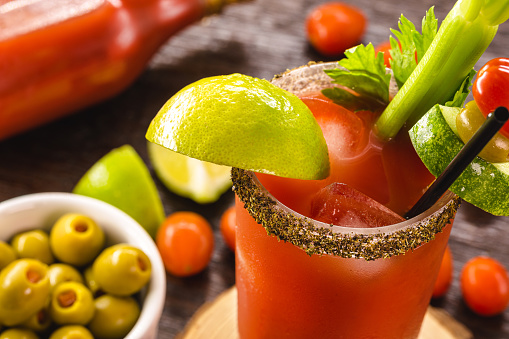A Bloody Mary is a popular cocktail that is typically made with tomato juice, vodka, and various spices and seasonings. One of the key ingredients in a Bloody Mary is tomato juice, which is known for its relatively high carbohydrate content. In this article, we will explore the carbohydrate content of a Bloody Mary, as well as some of the other nutritional components that are present in this popular drink.
First, let’s take a look at the carbohydrate content of tomato juice. According to the United States Department of Agriculture (USDA), one cup (240ml) of tomato juice contains around 8 grams of carbohydrates. This is roughly equivalent to the amount of carbohydrates found in a small apple or a slice of bread.
One of the main ingredients in a Bloody Mary is tomato juice, which is a good source of carbohydrates. A cup of tomato juice typically contains around 8 grams of carbohydrates, which is about 3% of the recommended daily intake for a person on a 2,000 calorie diet. Additionally, some Bloody Mary recipes may include additional ingredients that can contribute to the carbohydrate content of the drink, such as Worcestershire sauce, hot sauce, or horseradish. These ingredients, while they usually add a small amount of carbs, they are not considered to be significant.
The other main ingredient in a Bloody Mary is vodka, which is a distilled spirit that is typically made from fermented grains such as barley, corn, or wheat. Vodka is considered to be a low-carbohydrate alcohol, as it contains no carbohydrates or sugar. This means that the majority of the carbohydrates in a Bloody Mary come from the tomato juice.
When it comes to making a Bloody Mary, the amount of tomato juice used can vary depending on the recipe and personal preference. Some recipes call for as little as one cup of tomato juice, while others may use up to two cups or more. This means that the carbohydrate content of a Bloody Mary can vary widely depending on the recipe and the serving size.
In addition to the tomato juice, there are a number of other ingredients that are commonly used in a Bloody Mary. Many recipes call for the use of vodka, which is a distilled spirit that is made from fermented grains. Vodka itself is relatively low in carbohydrates, with roughly 0.1 grams per ounce (28ml).
Another popular ingredient in a Bloody Mary is Worcestershire sauce, which is a savory condiment that is made from a blend of ingredients including vinegar, molasses, anchovies, and spices. Worcestershire sauce is relatively low in carbohydrates, with around 0.5 grams per teaspoon (5ml).
Many Bloody Mary recipes also call for the use of various spices and seasonings, such as black pepper, cayenne pepper, and celery salt. These ingredients are typically used in small amounts and are generally considered to be low in carbohydrates.
Overall, the carbohydrate content of a Bloody Mary can vary depending on the recipe and serving size. However, it’s generally considered a low-carb drink as it’s made mostly of tomato juice and other ingredients that are low in carbohydrates. It’s also worth noting that a Bloody Mary can also be a good source of vitamins and minerals, including vitamin C, potassium, and folate.
In conclusion, A Bloody Mary is a popular cocktail that is made with tomato juice and vodka, and common spices. While the nutritional information for a Bloody Mary can vary depending on the recipe and ingredients used, it generally contains a moderate amount of carbohydrates. The majority of the carbohydrates come from the tomato juice, with vodka being a low-carbohydrate spirit. However, it’s important to note that many bars and restaurants may add additional ingredients to their Bloody Mary recipes, such as sugar or syrups, which can significantly increase the carbohydrate content of the drink.

 Home
Home Health
Health Diet & Nutrition
Diet & Nutrition Living Well
Living Well More
More












